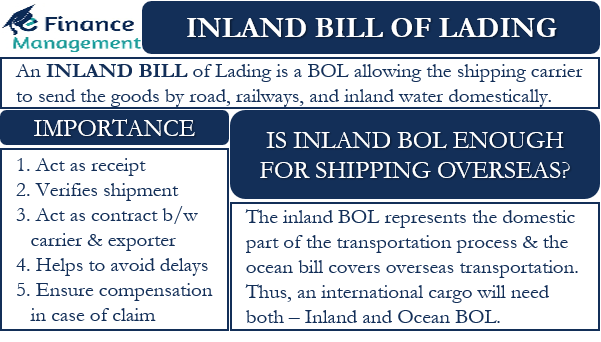International trade involves a lot of processes that businesses need to take care of. One such process is shipping the goods, and the Bill of Lading (BOL) is an important part of this process. BOL is basically a contract between the business and the shipping carrier. It specifies that the shipping carrier has got the goods. There are several types of BOL, but one of the most important BOL is the Inland Bill of Lading.
An Inland Bill of Lading is a BOL allowing the shipping carrier to send goods domestically by road, railways, and inland water. It doesn’t relate to sending the goods overseas. Therefore, it is an overland goods transportation contract. This BOL serves as a receipt from the carrier to the shipper covering the courier of products overland. Moreover, this BOL also works as a contract of carriage.
Inland Bill of Lading – Meaning
This BOL is usually the first transportation document of international cargo. Either shipper or the inland carrier can prepare this BOL. The carrier signs this BOL when it receives or picks up the shipment.
We can say that it is a contract between the supplier of cargo and the carrier. It carries all the shipment details, including the type of products, destination, place of origin, and more. Also, it carries detail about the transportation vehicle and the freight charges. It also acts as a receipt from the carrier that they are now in possession of the shipment. Also, for the carrier, it serves as proof of transportation.
Generally, this BOL isn’t sent to the international buyer of the products as it is for domestic overland transportation. However, it may be sent to the buyer indirectly through other related parties. These other parties are usually those who will ship the goods to the buyer once the domestic carrier delivers them.
These other parties could be the packaging company, international carrier, forwarder, warehouse, or any other party in the process. The inland BOL stays relevant up till the point at which the exporter’s international carrier takes the cargo in its possession.
If the inland BOL is not negotiable, it means the BOL should go to a specific consignee. And, if it is negotiable, the carrier who holds the bill of lading can change the route of the shipment.
Importance of Inland Bill of Lading
The following points will explain why businesses need to use Inland BOL:
Acts as Receipt
Since the carrier who picks the cargo signs it, it works as a receipt. The signature verifies all the details of the Inland BOL. This receipt also works as proof to get an insurance claim in case of any damage in transit.
Verifies Shipment
This Inland bill serves as proof of what the shipment includes. The bill includes all the shipment details, including the type of goods, the value of goods, the quantum of goods, where it is going, who will pay freight charges, and where the shipment is coming from.
Acts as Contract between Carrier and Exporter
Since one of the parties prepares the Inland BOL and both parties sign, it serves as a contract between the two. And therefore, both parties are expected to honor the terms of the contract.
Helps to Avoid Delays
If the supplier correctly fills the inland bill, it ensures that the carrier knows what needs to be done. This would help to avoid wastage of time in confirming the details.
Ensures Compensation in Case of Claim
If an exporter doesn’t have the Inland BOL, or it includes incorrect (incomplete) details, then it may get hard for an exporter to get the right claim, in case, of any loss in transit.

Is Inland Bill of Lading Enough for Shipping Overseas?
Even though the Inland Bill of Lading is very important for international trade, it alone isn’t sufficient to send goods to overseas buyers. Instead, the supplier would require one more document, and it is the “ocean bill of lading.”
A point to note is that the inland BOL represents the domestic part of the transportation process. And the ocean bill covers overseas transportation. Thus, an international cargo will need both – Inland and Ocean BOL.
It is important for an international carrier to verify the details in the Inland BOL. In case of any discrepancy regarding the details of the cargo in the two documents – Inland BOL and Ocean BOL, the latter gets more importance.
Final Words
Import and export of goods involve many processes, and the parties have to deal with several types of bills. And Inland BOL is just one part. An Inland BOL is always there, whether it is domestic or international transportation. In the case of imports, it is usually the last leg transportation document from the international carrier to the inland destination. Whereas in the case of exports, it is the first leg of transportation document from the factory to the international carrier.
It is vital for businesses to understand and keep a record of all these documents. Moreover, businesses must fill these documents accurately. These documents come in handy in case of any dispute, such as a delay, loss of shipment (part or full), damage, and more. So, along with Inland BOL, it is important for businesses to get knowledge of other documents as well.
Visit Bill of Lading and its Types for more details.

